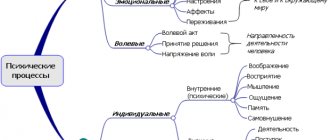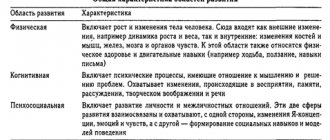Psychodiagnostics
Psychodiagnostics is a branch of psychology that studies methods for determining the psychological characteristics of a person in order to most fully reveal his internal potential in all spheres of life.
History of psychodiagnostics
The emergence of psychodiagnostics as an independent field of knowledge occurs at the end of the 19th century. This is due to a clear awareness of the need to assess the individual psychological characteristics of people in order to find solutions to various kinds of psychological problems. Thus, it can be argued that psychological diagnostics separated from psychology under the influence of practical requirements.
The initial source of the development of psychodiagnostics was experimental psychology; its foundations are laid in all psychodiagnostic methods. The study of mental phenomena and facts within the framework of the exact methods of the natural sciences, the increased influence of natural science on the analysis of mental phenomena served as an additional incentive for the development of psychodiagnostics.
It is believed that experimental psychology originated in Germany in 1878; its creator is considered to be Wilhelm Wundt, who founded the world's first laboratory of experimental psychology, the main task of which was to study human sensations and the accompanying motor reactions, color perception.
In 1883, Francis Galton included the measurement of hearing, vision and verbal associative reaction time in the science of anthropometrics, which he created, in addition to measuring tests of human physical parameters. However, F. Galton made a much more significant contribution to the development of psychodiagnostics a little later, having invented the concept of “test”.
Despite the development of psychodiagnostics as a result of the use of experiments, the study of man is not based on a purely logical development of the experimental method. The study of man was influenced by the needs of pedagogy, medicine and industrial production.
Various scientific psychological schools responded to these requests in different ways and presented the role of psychodiagnostics in the process of studying personality in their own way. The most noteworthy is the look at the psychodiagnostics of schools whose methods are directly related to the principles of behavioral psychology (behaviorism). The peculiarity of behaviorism was the recognition of the relationship between the external environment and the organism, while the organism, succumbing to the influence of the external environment, reacts to it and strives to change the current situation in a favorable direction for it and, ultimately, adapts to the external environment. Behavior in the behaviorism model is understood as a set of reactions of the body to stimuli. In accordance with this, the main goal of psychodiagnostics was to record human behavior. As a result of pursuing this goal, test methods were developed.
Purpose and application of psychodiagnostics
Psychodiagnostics is used in such areas of practice as:
1) psychotherapeutic assistance and consultation;
2) designing a person’s possible social behavior (for example, the degree of fidelity in marriage);
3) analysis of the degree of influence of changes in environmental conditions on the psychological state of a person;
4) career guidance, consultation in personnel selection;
5) forensic psychiatric examination;
6) organization of education and training;
7) analysis of interpersonal relationships and personality psychology.
The main goal of psychodiagnostics is to help people, during times of psychological stress, make the right decision with the least loss for their nervous system. It is to this goal that thousands of people who have embarked on the path of serving psychodiagnostics devote their lives.
Why is psychodiagnostics needed and how high is the likelihood of situations requiring the help of psychodiagnostics? A person can minimize the likelihood of making a wrong decision in two cases:
1) Make absolutely no decisions (in other words, sit on your hands). This option is not suitable for us, as it makes it impossible to achieve success. It is impossible to achieve anything without taking action.
2) Be a truly highly qualified professional in all areas of activity that a person encounters on the path to success. However, as you know, a person very rarely, almost never, is equally knowledgeable in all areas of life. But life is a fickle lady, and a person never knows for sure in what area he will have to implement his own knowledge. And this applies not only to work. Take the example of men who have recently become young dads - how many of them are absolutely ready for this?
Unpreparedness to face unexpected problems gives rise to fear, psychological constriction and suppression of initiative. In order to restore a person’s self-confidence, relieve him of the fear of the unknown, and change a falsely constructed model of human behavior, psychodiagnostics exists.
If we break down the term “psychodiagnostics” into its components, it is not difficult to guess that the subject of research in psychodiagnostics is:
a) the soul of a person, his inner world;
b) a detailed analysis of this inner world.
The term “diagnosis” is defined as the recognition of a person's deviation from his normal development and functioning. In order to identify these deviations, a psychodiagnostician analyzes the reasons, both internal and external, that force a person to act this way and not otherwise, and also analyzes the mental characteristics of a person during the study.
The problems of psychodiagnostics are solved in various ways
The first way is to observe a person in the process of providing him with psychotherapeutic assistance. The second way is to observe an individual in the process of his life, studying his motives and reactions. Both of these methods are excellent for studying basic information about a person, but they have some disadvantages, such as significant labor input, are not always available and applicable, and can provide distorted information about a person (in cases of short-term observations). Due to these shortcomings in psychodiagnostics, special techniques have been widespread that allow, within a short period of research, to obtain all the necessary information about the mental characteristics of an individual. In addition, the advantages of these methods include the ability to collect not only general information about a person, but also about his characteristics, personal characteristics (intelligence, self-esteem, etc.). It is these techniques that will be discussed further.
Psychodiagnostic methods
Figure 1 – Psychodiagnostic methods depending on the approach
All psychodiagnostic methods are divided depending on the approach to studying a person (see Fig. 1). There are objective, subjective and projective approaches. With an objective approach, the diagnosis of a person’s mental characteristics is determined on the basis of the methods used by a person when performing an activity and its effectiveness. According to the subjective approach, the analysis of mental processes is carried out by self-assessment of a person based on the information that the person provided about himself. With this approach, human behavior in certain situations is assessed. With a projective approach, the diagnosis of the psyche is carried out on the basis of the interaction of a person and external neutral material, which becomes the object of attention due to its uncertainty.
The objective approach presents two main types of methods - methods of testing intelligence and diagnosing personal abilities. The intelligence testing technique is aimed at determining a person’s mental development, and the personality ability diagnostic technique is designed to determine a person’s abilities that are not directly related to intelligence (the so-called character traits). The use of diagnostics of intelligence and character traits at the same time allows us to get an idea of the mental motives that guide a person when making decisions regarding his actions.
Diagnostics of the level of human intelligence development is represented by “intelligence tests”. The main types of intelligence tests are:
Culturally Fluent Intelligence Test (CFIT)
This test was invented by British psychologist R. Cattell in 1958. A distinctive feature of this test was the ability to diagnose the level of intellectual development of a person, regardless of the influence of environmental factors. An interesting example of this test is diagnosing the level of intelligence among children and adults without higher education. All tasks in the test are presented in the form of graphic images. The test consists of two parts with 4 subtests. Each test taker is given a test form with tasks, each task contains five answer options, and there is only one correct answer - this is what the test taker must choose. A strictly defined time is given for each part of the test.
After this time, the experimenter asks the subject to put the pen aside and begins counting points by checking the selected answer options with the key. According to statistics, the average IQ level is achieved when you score 90-110 points. An indicator above this mark is a sign of the presence of mental talent in a person; an indicator below this level, on the contrary, indicates that the person still has room to grow intellectually.
WISC (Wechsler Test)
The IQ scale was developed by David Wexler in 1939. This test diagnoses general intelligence and its components - verbal and non-verbal intelligence. Like the CFIT test, the Wechsler test is divided into 2 parts - the first part contains 6 verbal subtests, and the second contains 5 non-verbal subtests. Verbal subtests consist of diagnosing intelligibility, awareness, the ability to reproduce numerical series and finding similarities between objects and images. Non-verbal subtests include identification of the missing picture, addition of figures, encryption, addition of figures. Each test contains from 10 to 30 tasks, the complexity of which increases as they are completed. Each of the subtests is assessed in points and the final result is given (scale scores). In the process of calculating the result, each completed task is analyzed in detail, the ratio of verbal and non-verbal aspects of intelligence is determined, and the final IQ level is determined. Analysis of qualitative and quantitative assessment of task completion allows us to identify gaps in the intellectual development of one or a couple of aspects of human activity and outline methods for eliminating them. A low score on any of the subtests indicates a violation in the development of one of the aspects of human activity. The classification of scores and their corresponding IQ levels are given below:
- 130 points and above – very high IQ level
- 120-129 points – high IQ level
- 110-119 points – good normal IQ level
- 90-109 points – average IQ level
- 80-89 points – low level
- 70-79 points – limit zone
- 69 points and below – mental deviation.
Raven's Progressive Matrices
This technique for diagnosing intelligence was presented in 1936 by the famous English psychologist John Raven. The author of the technique was absolutely convinced that the best method for measuring the “g factor” (the factor of a person’s general intelligence) was to find relationships between abstract figures. When creating the methodology, the main task of the psychologist was to invent tests that were easy to understand and convenient for processing the results, and at the same time were theoretically justified.
At the beginning of the test, the subject is provided with drawings with figures interconnected by a certain dependence, while one of the figures is missing and is given as one of the answer options for the test among 4-8 other figures. The subject’s task is to determine the logical sequence between the figures and select the correct option that corresponds to the pattern of arrangement of the figures, as well as reflect the number of the selected option in the questionnaire.
The Raven test consists of five blocks containing 60 tables. With each transition to the next block the task becomes more complicated.
The time to complete this test is 20 minutes; completing tasks beyond this time is unacceptable. Choosing the correct answer to a task earns the subject one point. At the end of the test, the scores are summed up and conclusions are drawn regarding the degree of human intelligence development - with a score of 0-20 points, the development is assessed as very weak, bordering on idiocy, and with a score of 140 points or more - as a high level of intelligence development.
Amthauer Structure of Intelligence Test
This test was developed to determine the general level of abilities, since professional diagnostics experienced certain difficulties. When creating the test, Amthauer relied on the opinion that intelligence is nothing more than a substructure in the overall structure of personality, which has a close relationship with the emotional sphere of a person’s life, his interests and needs. The structure of the test consists of 9 sections, each of which contains 16-20 tasks. The time to complete each task from the sections is strictly specified - from 6 to 10 minutes, depending on the complexity of the section. In such a short period of time, a person is unlikely to have time to complete all the tasks, and therefore the optimal strategy is to quickly move from a task to which the person is not sure of the correct answer to the next task.
Subject and tasks
The subject includes methodology, techniques and requirements for them, as well as concepts and principles used to develop methodological approaches to research and drawing conclusions. There are regulatory requirements that must be relied upon when conducting any psychodiagnostic research.
The task of the scientific process is to study the personality characteristics of an adult or child, classify them, determine what is characteristic of him, and how his behavior may change over time. For each quality, you can determine how expressed it is and assign a quantitative expression. The characteristics of a person are described when required. Tasks and situations may be different, and taking this into account, the main approaches and methods differ.
The essence of psychological diagnostics
The essence of psychological diagnostics lies in the effectiveness of educational and cognitive work with children. It is important to note whether there are changes in the child’s development, in his motivational sphere, in the development of self-esteem, generalized forms of thinking, semantic memorization, etc. A teacher-psychologist should know:
- what and how to study in the cognitive, volitional, personal sphere of children;
- what methods can be used;
- how to process the received data;
- where the results can be used (according to the “do no harm” principle);
- how to develop correctional work with children.
“The educator must know a person in the family, in society, at all ages, in all classes, in all positions, in joy and sorrow, in greatness and humiliation, in excess of strength and in illness, among unlimited hopes and on the deathbed, when the word human consolation is no longer powerless. He must know the motives of the dirtiest and highest deeds, the history of the origin of criminal and great thoughts, the history of the development of every passion and every character. Only then will he be able to draw from the very nature of man the means of educational influence - and these means are enormous,” K.D. Ushinsky rightly asserted. The subject of psychological and pedagogical diagnostics is reflected in the following studies:
- Burlachuk L.D., Morozov S.M. Dictionary-reference book for psychological diagnostics. – St. Petersburg: Peter, 1999.
- Diagnosis and correction of mental development./ Ed. Ya.L. Kolominsky, E.A. Panko.
- Diagnostic component. Study of the characteristics of the development of the cognitive sphere of children of preschool and primary school age. – M., 1999.
- Counseling children in a psychological and pedagogical center./ Ed. L.S. Alekseeva. – M., 1998.
- Kochetov A.I. The culture of pedagogical research.
- Kochetov A.I. Pedagogical diagnostics at school. – M., 1987.
- Kukharev N.V., Reshetko V.V. Diagnostics of teaching skills and pedagogical creativity.
- Laak Ya.G. Psychodiagnostics: the problem of content and methods. – Voronezh, 1996.
- Determination of children's functional readiness for school. L. 1981.
- Pedagogical diagnostics. M., 1999.-672 p.
- Psychological diagnostics of children and adolescents. Ed. K.M. Gurevich. – M., 1995.
- Psychological diagnostics. Ed. K.M. Gurevich.
- Psychological, medical and pedagogical examination of the child. Set of working materials. Ed. MM. Semago. – M., 1999.
- Raigorodsky D.Ya. Assessing the degree of readiness for school.
- Semago N.Ya., Semago M.M. Problem children: the basics of diagnostic and correctional work. - M., 2001.
- Semenchenko P. Encyclopedia of Intelligence. - M., 2000. - A collection of exercises and puzzles with the aim of teaching children to think independently and creatively.
- Scheme of neuropsychological examination of children. Ed. H.L. Semenovich. – M., – 1998.
- Tsvetkova L.S. Methodology for diagnostic neuropsychological examination of children. – M., 1997.-85 p.
- Emotional disorders in childhood and their correction. – M., 1990.
Methodological basis
Psychodiagnostics stems from general psychology and is based on differential psychology. Science studies the principles, essence and patterns by which the human psyche functions, patterns of development and unique personality traits are formed.
The methodological basis of psychodiagnostics and psychology largely coincides. Both directions are based on similar scientific, specific and philosophical categories. The principles that experts operate with:
- non-judgmental;
- specificity;
- relationship between quality and quantity;
- dialectical understanding;
- unity of activity and consciousness;
- development;
- reflections.
Without being a specialist, you should not resort to the possibilities of discipline, much less try to diagnose friends and relatives. If there are problems, it is necessary to contact competent specialists known in scientific circles.










